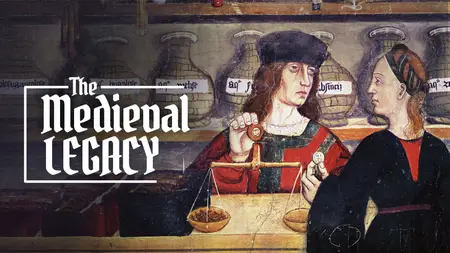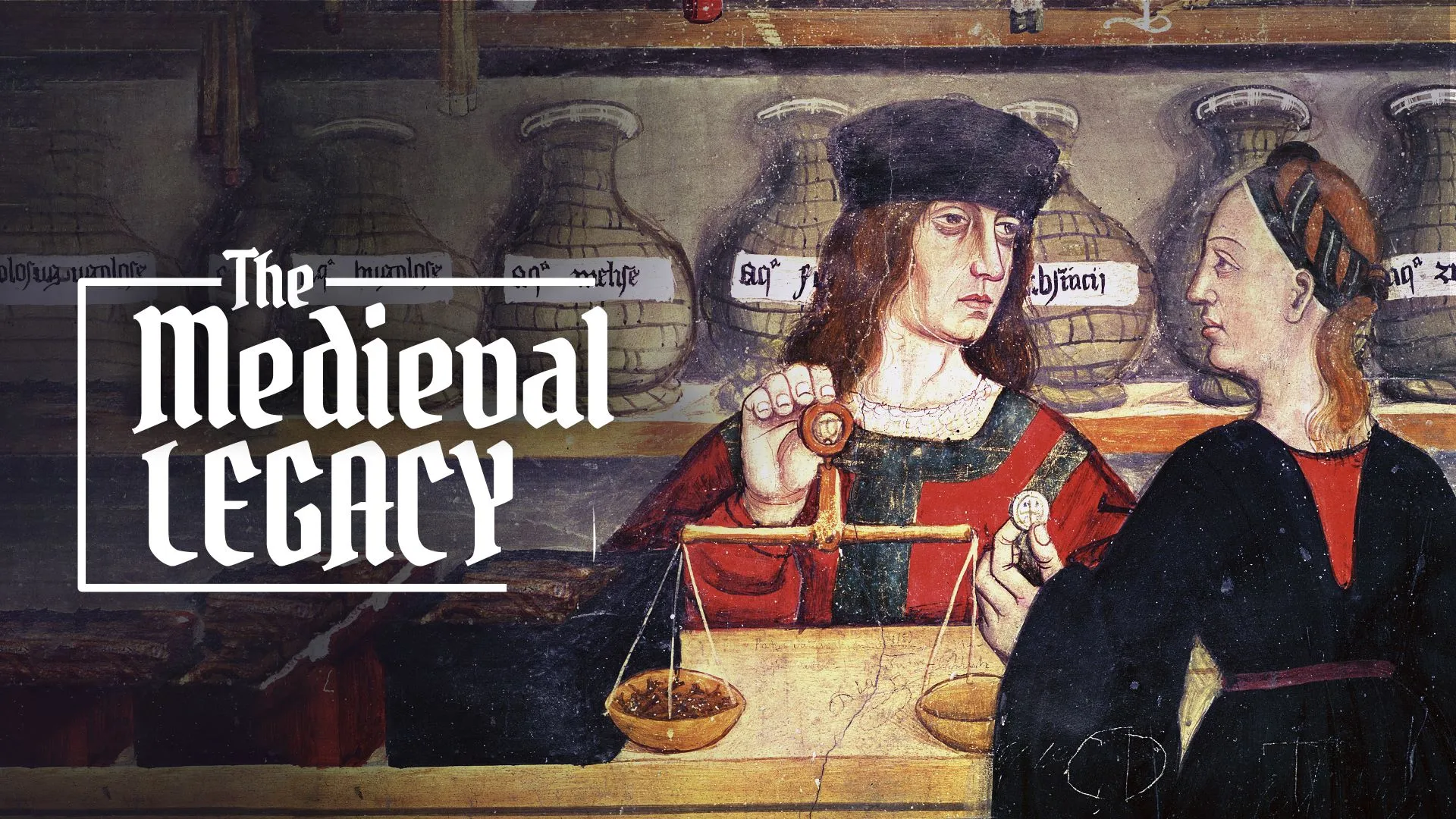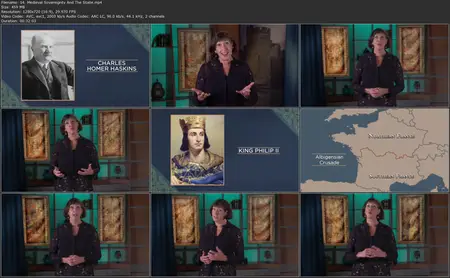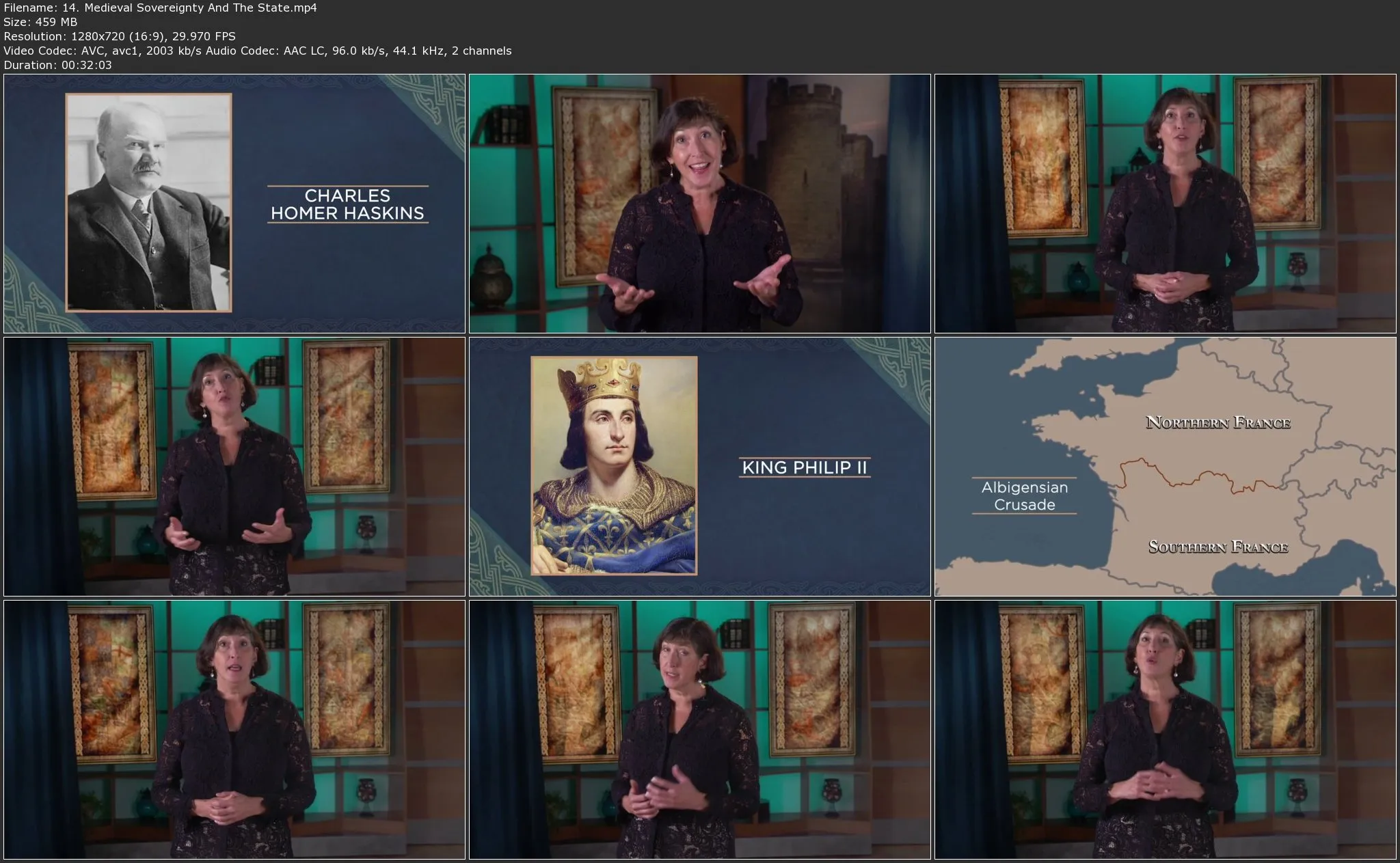TTC Video - The Medieval Legacy
.MP4, AVC, 1280x720, 30 fps | English, AAC, 2 Ch | 18h 19m | 15.3 GB
Lecturer: Carol Symes, PhD Professor, University of Illinois Urbana-Champaign | Course No. 3923
.MP4, AVC, 1280x720, 30 fps | English, AAC, 2 Ch | 18h 19m | 15.3 GB
Lecturer: Carol Symes, PhD Professor, University of Illinois Urbana-Champaign | Course No. 3923
Though it ended five centuries ago, the medieval era continues to reverberate through our world in far-reaching ways. The influences and imprints of the Middle Ages are all around us, sometimes in obvious incarnations and sometimes in much less immediately noticeable ways.
Perhaps the most visible legacies of the Middle Ages are the majestic cathedrals, palaces, castles, and cityscapes that still stand, as well as the era’s glorious paintings, sculpture, decorative arts, and enduring works of literature, music, and scholarship. We also see the impact of the Middle Ages in the medieval games we play, such as tennis and chess, and in a plethora of current novels, TV dramas, and movies.
But beyond these glowing reminders of bygone times, the medieval world influences our modern world in numerous other ways—a legacy that reveals itself in our institutions, our cultural pursuits, and some habits of life and thought that can be directly traced to the medieval period:
But these are only some of the areas in which the medieval world influences ours and shapes our collective consciousness. If we look with discernment, we can see the mark of the Middle Ages in the codes of honor that we value; the national narratives that undergird ideas of identity and belonging; how we make money and manage financial risk; our standards of justice; our notions of race; and our methods of scientific proof; as well as in features of daily life such as how we tailor our clothes, the languages we speak, and how we structure our time.
To find these remarkable connections in the medieval world and to see their enduring impact on ours is to deeply enrich your understanding of both the unfolding of history and the complex processes that gave us the world we know today.
Travel Deeply into the Ethos of the Medieval World
In the 36 eye-opening lectures of The Medieval Legacy, you’ll delve into our rich and colorful medieval heritage in compelling depth and detail. Your guide is celebrated medieval scholar Professor Carol Symes of the University of Illinois at Urbana–Champaign, whose diverse and informed commentary shines a light on both the visible and the less obvious links between the medieval world and our own.
In this unique inquiry, you’ll learn how to recognize medieval impacts on the modern world, and to grasp their significance and implications. In doing so, you’ll delve into aspects of the medieval legacy that we may prize and want to keep, as well as its shadow side—features of the legacy that we struggle with. Among the latter, you’ll see that anti-Semitism arose specifically within the medieval world, and you’ll witness how its familiar and destructive tropes developed.
Throughout the course, you’ll take a careful look at the ideas, claims, and fantasies about the medieval past that have had a profound impact on modern culture and society. And you’ll investigate how the medieval past has been co-opted over the last two centuries to bolster claims of nationalism and to justify wars, territorial aggression, and modern movements of white supremacy.
You’ll come to grips with the scope of the medieval era’s influence on our own era, and, in Professor Symes’s words, “the extent to which our own deeply held, often unconscious ideas about identity, tradition, order—what is normal, what is immutable—are part of the medieval legacy.” Bolstered by her challenging and incisive perspective, this is a historical inquiry of extraordinary relevance and meaning.
Explore Medieval Connections with Our Ways of Life and Thought
You will embark on a wide-ranging immersion into the medieval world, uncovering significant ties to our contemporary lives. Among these, you’ll investigate:
Savor the Richness of a Magnificent Epoch
Throughout the course, individual lectures highlight our heritage from the Middle Ages as it affects daily experience: in the kinds of paperwork we live with every day; the ways we read and publish texts; the medieval inventions we use, such as clocks and eyeglasses; how we compose poetry and novels; the universities we attend; and more.
Finally, in her gripping commentary, Professor Symes brings the medieval world vividly alive through remarkable specificity and detail. In a lecture on medieval finance, you’ll enjoy a sumptuously detailed look at the colorful accounting system of the English Exchequer—a huge table that functioned like a giant abacus. In studying medieval trade guilds, you’ll witness the extravagant York theatrical pageants and elaborate outdoor Passion plays, for which a myriad of trades created the staging. And, in exploring medieval pastimes, you’ll study a richly detailed image of a chess match, portraying the complex social ceremony of the game and the distinctive costumes of the players and watchers—forms of dress that persisted until the early 20th century and live on in modern formal wear.
The Medieval Legacy offers a deep look at a stunning millennium of change and innovation which continues to inform our contemporary world.
- Although the framers of the US Constitution studied ancient Greek and Roman government, they were influenced more directly by medieval models, as Jefferson acknowledged when he praised “the Saxon chiefs from whom we claim the honor of being descended, and whose political principles and form of government we have assumed.”
- Our sense of personal identity as being citizens of nations came into being through the long debate over statehood and national sovereignty that raged during the Middle Ages.
- Within Christianity, the religious doctrines and tenets of belief that define the Roman Catholic Church, the Eastern Orthodox Church, and the many Protestant faiths were forged during the medieval world.
- Intolerance of prostitution and LGBTQ sexual orientations, which are still divisive issues in the 21st century, originated as specific forces within later medieval society, following centuries of remarkable sexual diversity and tolerance, which included the incorporation of sex workers’ guilds.
- The use of crusading rhetoric by Western conservatives and Islamic militarists in the decades following September 11, 2001, is the living heritage of the medieval ideology of “holy war,” both Christian and Muslim, and is a particularly thorny instance of the medieval legacy.
But these are only some of the areas in which the medieval world influences ours and shapes our collective consciousness. If we look with discernment, we can see the mark of the Middle Ages in the codes of honor that we value; the national narratives that undergird ideas of identity and belonging; how we make money and manage financial risk; our standards of justice; our notions of race; and our methods of scientific proof; as well as in features of daily life such as how we tailor our clothes, the languages we speak, and how we structure our time.
To find these remarkable connections in the medieval world and to see their enduring impact on ours is to deeply enrich your understanding of both the unfolding of history and the complex processes that gave us the world we know today.
Travel Deeply into the Ethos of the Medieval World
In the 36 eye-opening lectures of The Medieval Legacy, you’ll delve into our rich and colorful medieval heritage in compelling depth and detail. Your guide is celebrated medieval scholar Professor Carol Symes of the University of Illinois at Urbana–Champaign, whose diverse and informed commentary shines a light on both the visible and the less obvious links between the medieval world and our own.
In this unique inquiry, you’ll learn how to recognize medieval impacts on the modern world, and to grasp their significance and implications. In doing so, you’ll delve into aspects of the medieval legacy that we may prize and want to keep, as well as its shadow side—features of the legacy that we struggle with. Among the latter, you’ll see that anti-Semitism arose specifically within the medieval world, and you’ll witness how its familiar and destructive tropes developed.
Throughout the course, you’ll take a careful look at the ideas, claims, and fantasies about the medieval past that have had a profound impact on modern culture and society. And you’ll investigate how the medieval past has been co-opted over the last two centuries to bolster claims of nationalism and to justify wars, territorial aggression, and modern movements of white supremacy.
You’ll come to grips with the scope of the medieval era’s influence on our own era, and, in Professor Symes’s words, “the extent to which our own deeply held, often unconscious ideas about identity, tradition, order—what is normal, what is immutable—are part of the medieval legacy.” Bolstered by her challenging and incisive perspective, this is a historical inquiry of extraordinary relevance and meaning.
Explore Medieval Connections with Our Ways of Life and Thought
You will embark on a wide-ranging immersion into the medieval world, uncovering significant ties to our contemporary lives. Among these, you’ll investigate:
- Representative Government and Organized Labor. Find the origins of the forms of representative government that we now take for granted in the general assemblies and councils that emerged in many medieval societies. Observe how medieval trade guilds evolved, prefiguring our own labor unions, both in the protections they offered and the social dialogues they fostered.
- Romance and Chivalry. Delve into the powerful and enduring culture of chivalry, whose moral ideals and codes of valor still resonate strongly today in literature and popular culture. See how these ideals took shape in medieval epics, chivalric romance literature, song, and storytelling, often under the patronage and authorship of women. And observe how and why these codes were adopted by warring knights and carried forward by aristocracies into the 20th century.
- The Scientific Method. Learn why, contrary to many popular perceptions, the origins of the scientific method are found in the Middle Ages, not the early modern era. Study the work of the great medieval scientists from al-Haytham and Avicenna to Ockham and Copernicus. Consider their integral contributions to the inductive-deductive method and the experimental science that gave us the modern world.
- The Roles of Medieval Women. Within the fabric of medieval societies, take account of the remarkable and often forgotten contributions of women. Learn about pioneering medieval authors Christine de Pisan, Margery Kempe, and Hildegard of Bingen. Uncover the lost legacy of medieval women artists and encounter Jeanne d’Arc, Eleanor of Aquitaine, and other women who took leading roles in politics and war.
- Race Thinking and Racism. Trace how the notion of race arose in the 14th and 15th centuries, following an earlier medieval culture in which prejudice was not usually based on physical differences. Observe the workings of religious ideology, travel literature, and the racialization of slavery in constructing concepts of “white” European superiority, and the passing down of those concepts to our own time.
- Currents of Medieval Theology. Over three lectures, track the origins of key elements of Christian theology that form an important part of many church traditions. Follow how medieval Christian leaders crystallized both orthodoxy of doctrine and its counterpart, heresy. See how the still-current cult of the Virgin Mary arose and locate the medieval origins of the doctrine of Purgatory.
- The Phenomenon of Medievalism. Examine the ways in which the medieval past—or popular ideas about it—have been claimed and appropriated in more recent times. Find medievalism in 19th-century British movements in art and decorative arts; European and American architecture; nationalist movements, and both World Wars; as well as in our own era’s literature, film, and popular culture.
Savor the Richness of a Magnificent Epoch
Throughout the course, individual lectures highlight our heritage from the Middle Ages as it affects daily experience: in the kinds of paperwork we live with every day; the ways we read and publish texts; the medieval inventions we use, such as clocks and eyeglasses; how we compose poetry and novels; the universities we attend; and more.
Finally, in her gripping commentary, Professor Symes brings the medieval world vividly alive through remarkable specificity and detail. In a lecture on medieval finance, you’ll enjoy a sumptuously detailed look at the colorful accounting system of the English Exchequer—a huge table that functioned like a giant abacus. In studying medieval trade guilds, you’ll witness the extravagant York theatrical pageants and elaborate outdoor Passion plays, for which a myriad of trades created the staging. And, in exploring medieval pastimes, you’ll study a richly detailed image of a chess match, portraying the complex social ceremony of the game and the distinctive costumes of the players and watchers—forms of dress that persisted until the early 20th century and live on in modern formal wear.
The Medieval Legacy offers a deep look at a stunning millennium of change and innovation which continues to inform our contemporary world.





